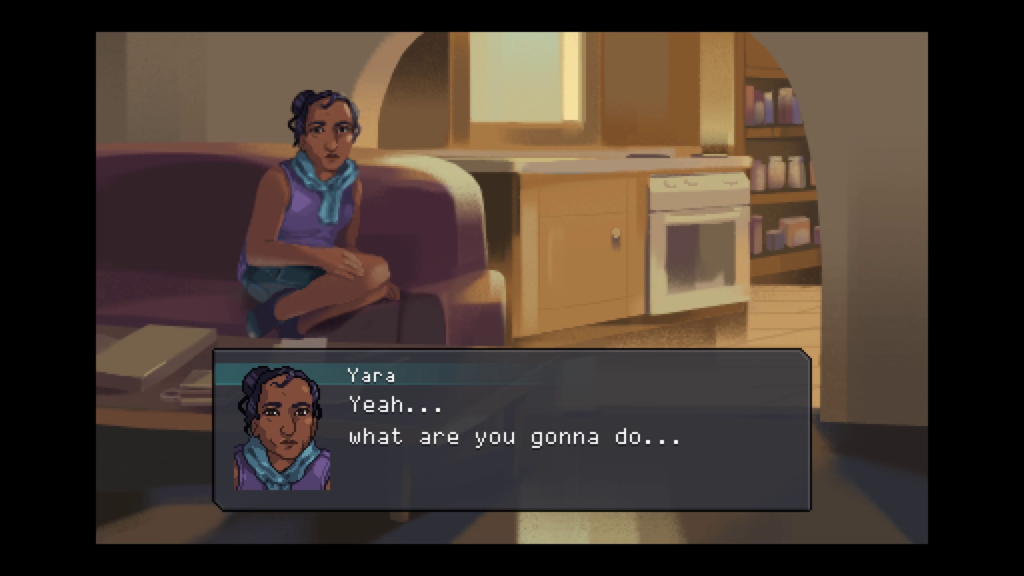Published 23 May 2022
I made a video adaptation of this review on my YouTube channel. Please check it out! Though this written version is nice too and not textually identical.
Anodyne holds a special place in my heart. So I was excited for the second video game from Analgesic Productions, the two-person team Melos Han-Tani and Marina Kittaka: Even the Ocean, a story-focused sidescrolling platformer released in 2016 and available on itch.io, Steam, and GOG. In a noble effort to unite story and gameplay, both focus on the theme of “balance” between the light and dark energies that are the focus of the fantasy setting’s science and society. While the later “gauntlet” levels become lengthy, Analgesic Productions gives dialogue and character interactions priority by their sheer volume.
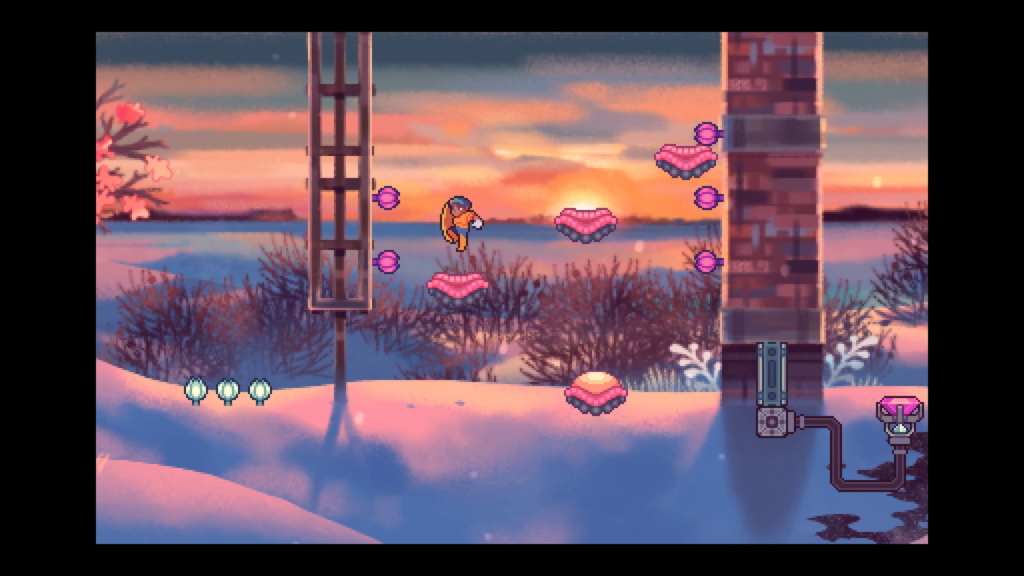
My playthrough of Even the Ocean took about ten hours. The gameplay loop consists of being assigned a series of missions to complete, walking to them on the overworld map, completing some tedious interactions with minor characters, and then running through the “gauntlet” stage before returning to the central city Whiteforge and, later, Karavold to partake in some culture or at least read some dialogue and repeat the process. Most of the gauntlets are malfunctioning power plants, though so abstract in their designs that, in a setting full of concrete details and deliberate worldbuilding, I felt constantly distracted by the question of what these spaces were supposed to be or who could have built them so irrationally. There are some enemies, strange creatures called “spores,” but the player character, the power plant technician Aliph, is not equipped for combat. As with the robots in Knytt Underground, these enemies are more in the character of obstacles. But obstacles there are aplenty.
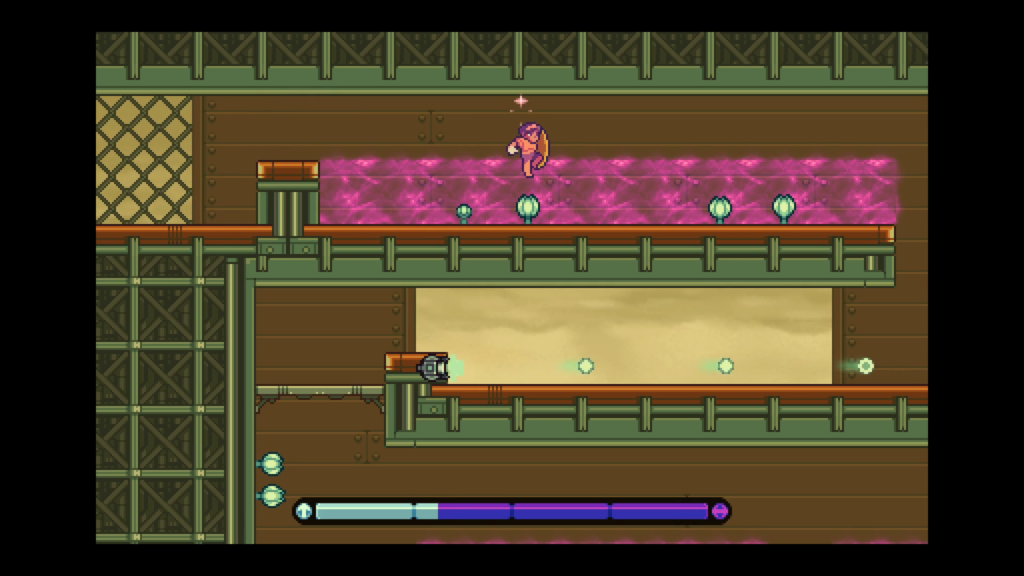

Aliph has no health bar but, instead, a balance between light (green) and dark (purple) energy displayed at the bottom of the screen. Depending on their color, some obstacles, traps, and other features of the environment, primarily flowers but also including lasers, mist, and the aforementioned spores, will raise Aliph’s light or dark energy level. More dark energy allows Aliph to move more quickly horizontally, jumping longer to clear wider gaps, but not jumping as high. More light energy allows Aliph to jump farther and more quickly vertically but more shortly and slowly horizontally. Different sections require both extremes. If the bar completely fills with either dark or light energy, however, Aliph’s body becomes too unbalanced, and she dies, returning the player to the previous checkpoint, non-diegetic statues of the Black Mage-like Storyteller who narrates the adventure. Aliph also wields a salvaged shield the player can—and must—use to block some energy blasts and, occasionally, to bounce off lasers and grind along rails.
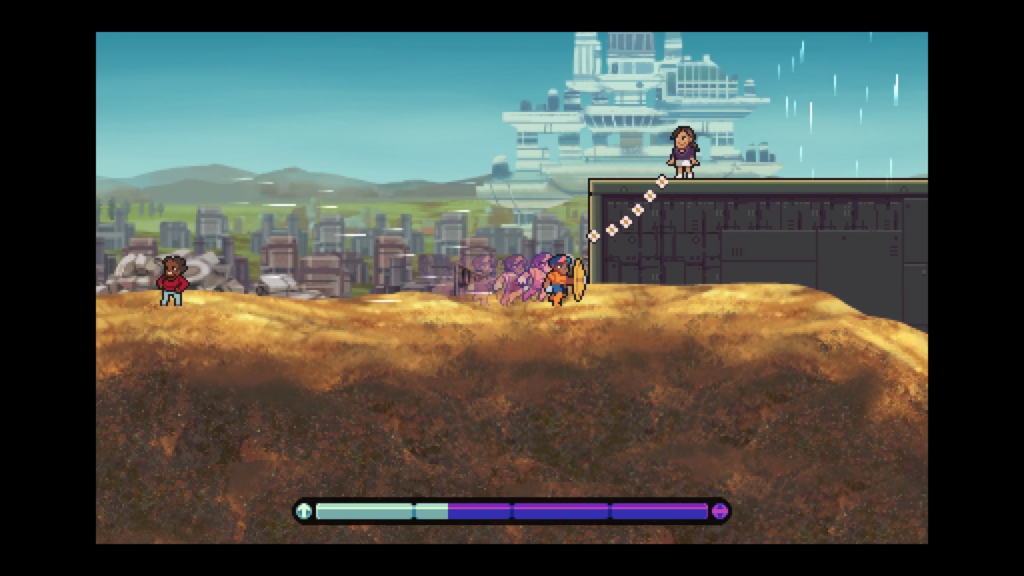
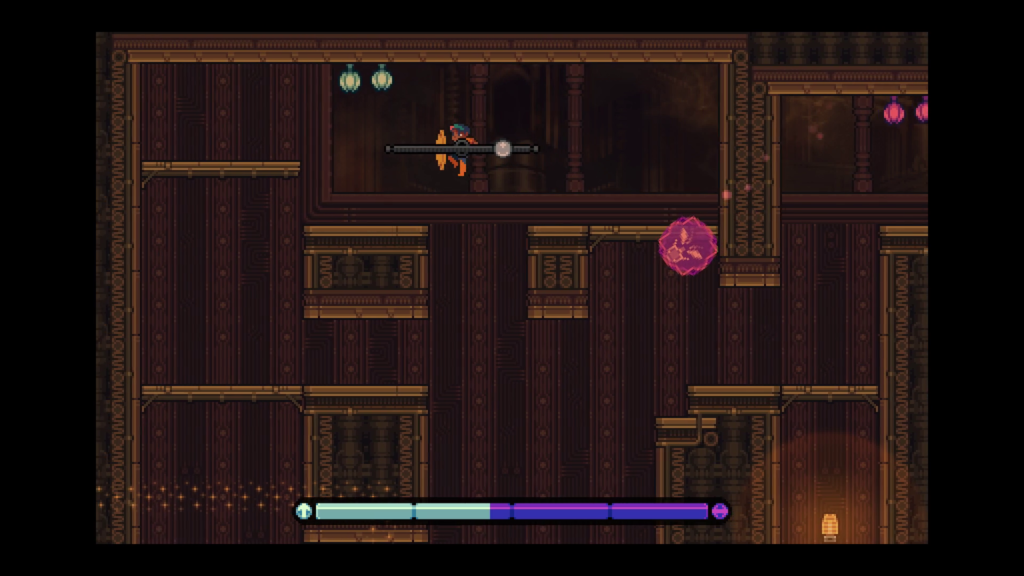
In the final section of the gauntlet, the player will find, instead of a boss fight typical of the genre, poles with sliding lenses that break upon contact with light or dark energy concentrations. To complete each gauntlet, the player must maneuver these lenses intact through more obstacles and into slots. In addition to timing, these segments have a puzzle aspect. The final step—a simple puzzle to redirect beams of light and dark energy—is trivial enough to warrant no further description. The initial gauntlet levels are extremely easy, but the later ones become more challenging. Even so, Even the Ocean is never difficult, especially in comparison with the frantic broom combat of Anodyne.

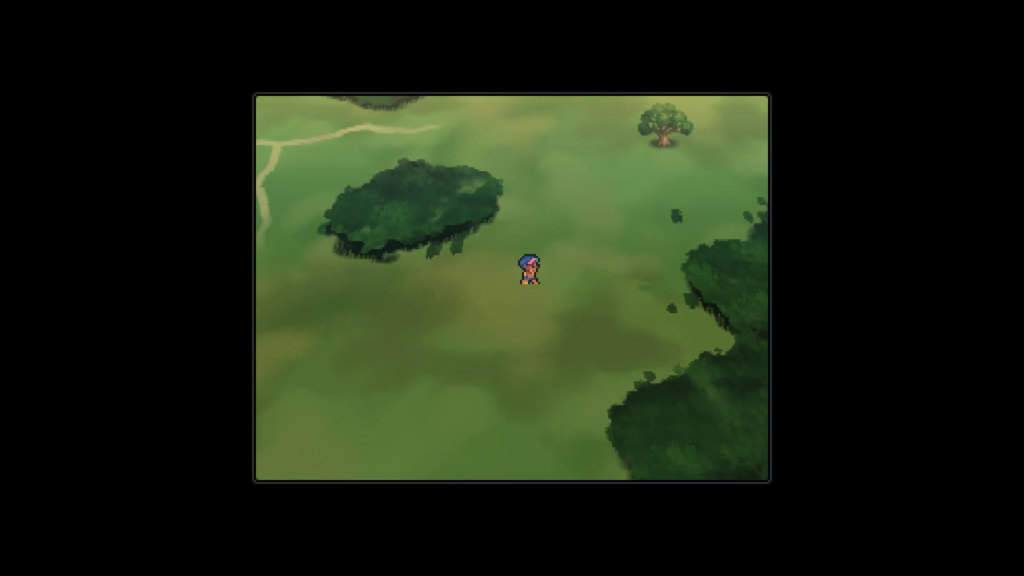
Outside of sidescrolling towns and gauntlets, Even the Ocean features a Dragon Quest-style overworld with a top-down perspective, super deformed character sprites the size of cities and mountains marching across an otherwise proportionate map. Without constant random encounters disrupting the explorative appeal, Even the Ocean promises discovery. The player’s ability to investigate any interesting objects and places seems poised to reveal so many secrets to flesh out this wide-open world full of towns and the occasional traveler. Unfortunately, none of this potential is realized. There is little hidden content, what there is amounting to a few lines of dialogue from Aliph. There is (I think) only one optional area to visit. No quests will ever see Aliph return to towns she has gone to on the job, and returning to old areas never showed me any new scenes. Attempts to wander anywhere the plot, or rather Aliph’s boss, does not demand the player be result in Aliph shutting down exploration with a line like “I should really get back to the city before doing anything else.” As a result, the overworld, the numerous towns, and the enormous cast of undeveloped characters, many of whom exist as vehicles for gentle and unfunny humor, feel more like padding between gauntlets and interactions with the few meaty members of the cast: Yara, Biggs, Wodsnick, and, in the final two chapters, Humus, as well as a few other more substantial characters. On the second set of overworld maps, the Outer Continents, exploration becomes a better utilized mechanic as the player tries to locate the next gauntlets, but it is still too limited and makes the primary overworld map feel only more barren and underwhelming.
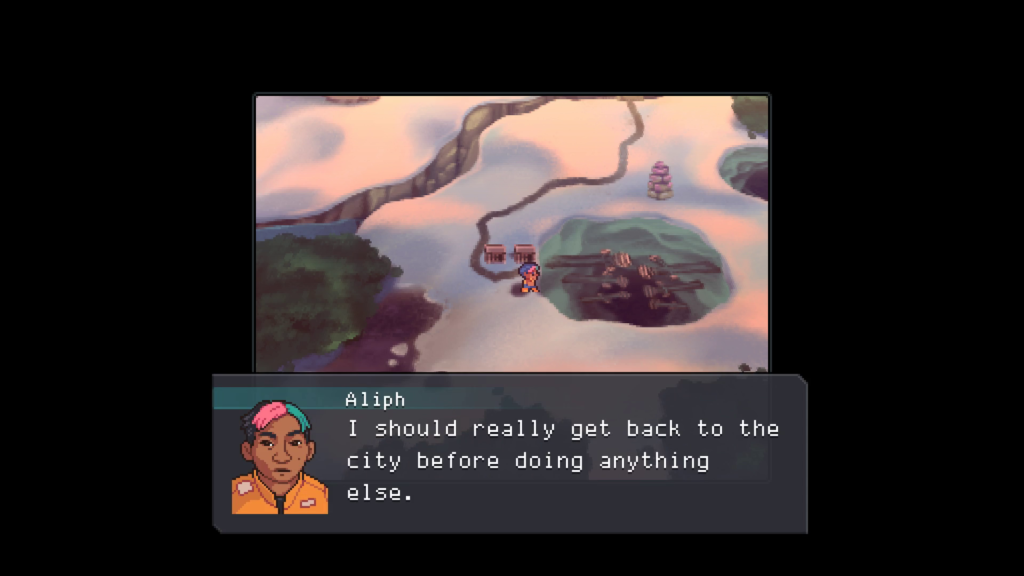
What I have described is the “Full Game” mode. In an extraordinary touch, Analgesic Productions also include “Story” mode, which excises all these gauntlet levels, and “Gauntlet,” which takes out all the story. “Warp” is an additional option created especially for people like me who want to skip around Even the Ocean at will to study it.
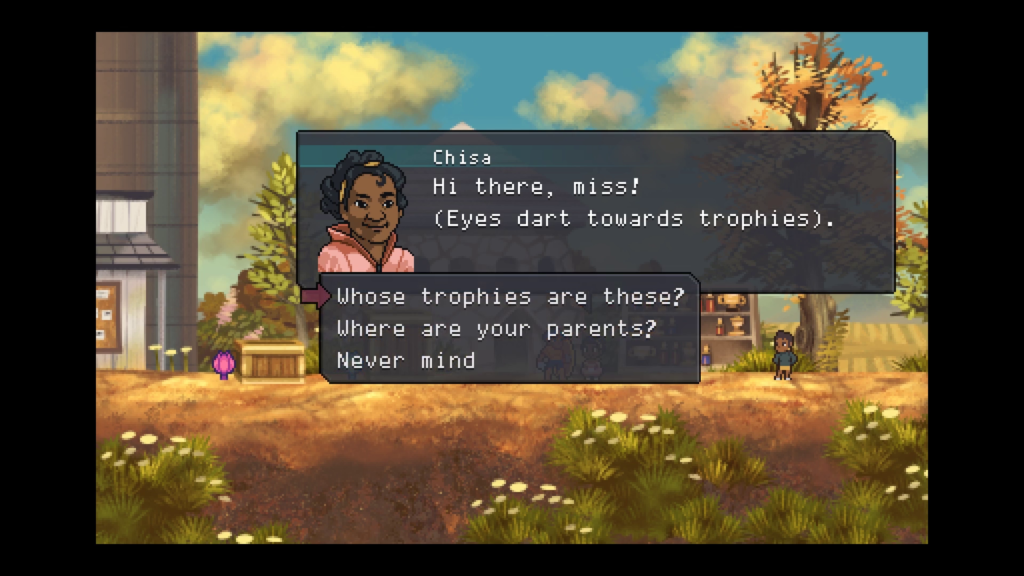
As an effort from such a tiny studio, Even the Ocean is hugely impressive, with lush pixel art graphics, a beefy script featuring dozens of characters, and an enormous soundtrack unmistakably like that of Anodyne in instrumentation but with the far less “catchy” and far more eerie and ethereal quality that has defined Han-Tani’s post-Anodyne music. The barely-there soundtrack often blends so seamlessly into diegetic wind and chirping and whirring that it is difficult to determine what is “music” and what just sound. Despite a tragic opening act and frequent darkness, most of Even the Ocean maintains a mellow tone that, mixed with this gentle music, a slow pace, and the gradual escalation of tight and fun if easy and simple platforming, results in a relaxing experience. That is, until the last two of the five chapters, when the plot swerves into horrifying territory.
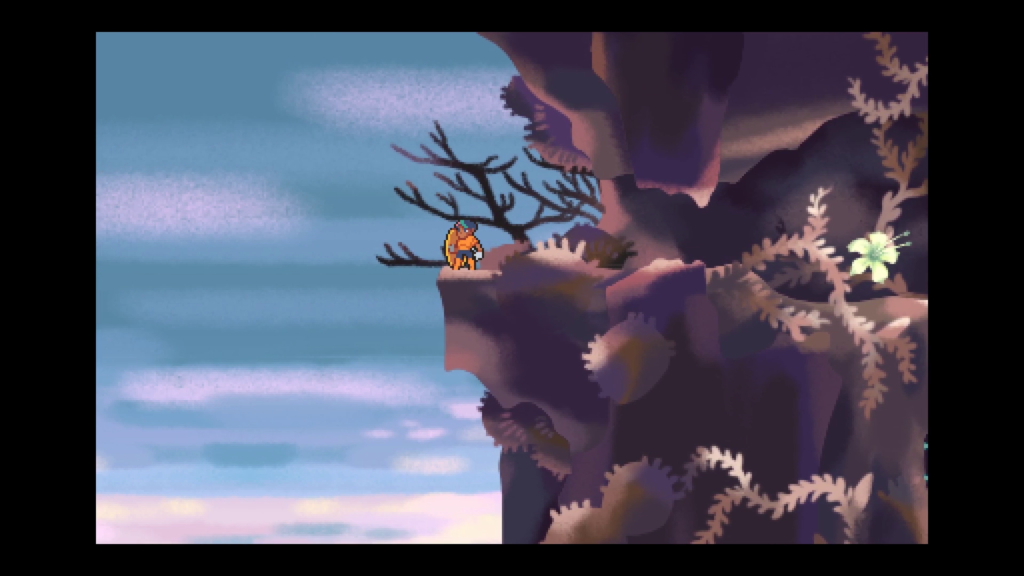
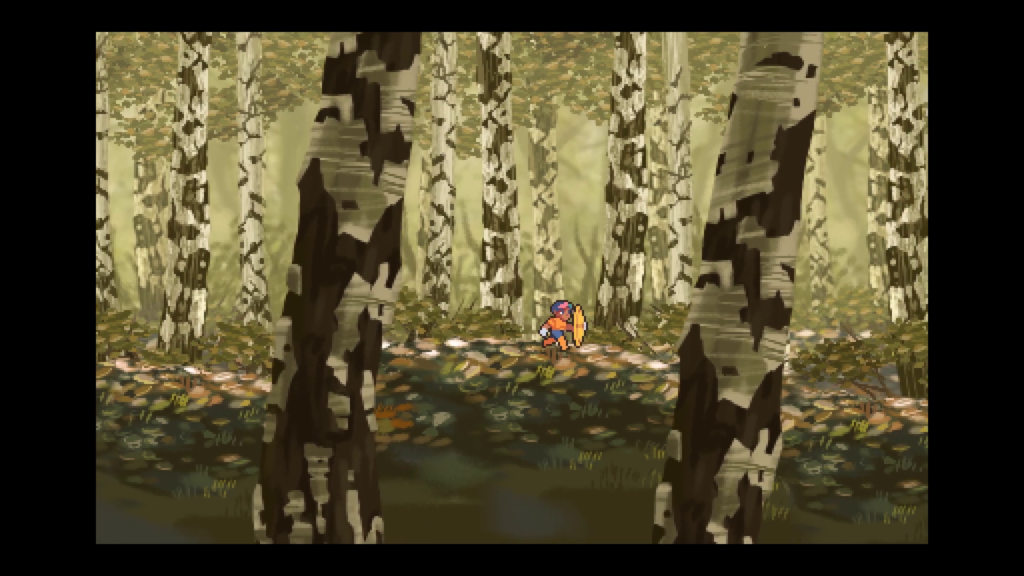
Even the Ocean is the rare platformer with a narrative focus. While competent, the platforming sections are so disconnected from the worldbuilding and action that, despite their focus on the balance theme and emphasis on defensive action (the shield) instead of offensive violence, they feel narratively expendable. They are at least expendable enough that Kittaka and Han-Tani welcome players to skip them. Although cutting these reflex-based challenges is great from an accessibility perspective, from the perspective of video game structure, if the interactive part can be removed with no change in meaning, the video game might be better off as a “visual novel” or comic. Even the Ocean is hardly the only video game guilty of this jarring disconnection (I’m looking at you, Final Fantasy I–IX and probably also the others). But given the attempt to thematically blend the two aspects of the story’s form, Even the Ocean is laudable—but my word choice is deliberate: it is a noble attempt. In comparison, a video game like PALACE OF WOE unites its story and gameplay to the point of inseparability, for there the gameplay, overcoming challenges and sorting the environment to sort the protagonist’s true identity from a mélange of obstacles and confusion, is the story. For all of that, Even the Ocean is still an enjoyable, if barebones, platformer.
The centrality of narrative to Even the Ocean means story will be my focus for the rest of this review. If you do not want it “spoiled,” please do not read on.
If, in judging the story, I seem harsh or nitpicky, this criticism comes from a place of respect. In a video game with political themes striving for literary seriousness, I believe narrative scrutiny is more worthwhile and necessary than in something frivolous like Hinedere Beat.
For most of the plot, Aliph has little agency, obeying whatever orders she receives initially from Hastings, her boss who rapidly vanishes from the story, and then from Mayor Biggs and Dr. Wodsnick. However, I do not consider this a flaw. I am skeptical of the traditional writing advice that a “good” protagonist must have substantial agency. Many of us in real life similarly spend most of our days powerless. Aliph’s obedience, in a bit of a (good) video game cliché dating back at least to Metal Gear, is also thematically relevant. In the end, the world is consigned to destruction because Aliph fails to interrogate the unjust and unsustainable power structures she serves. As Aliph says when the sky is red, and she realizes every whimsical child and disgruntled clown she met is doomed, “I don’t know anything about anything! I just… I just did what I was supposed to do!” Emphasis mine. As is often the case, however, this falls somewhat flat when the player has no choice to ever not be complacent, though Analgesic Productions would correct this narrative shortcoming in their next release, Anodyne 2.
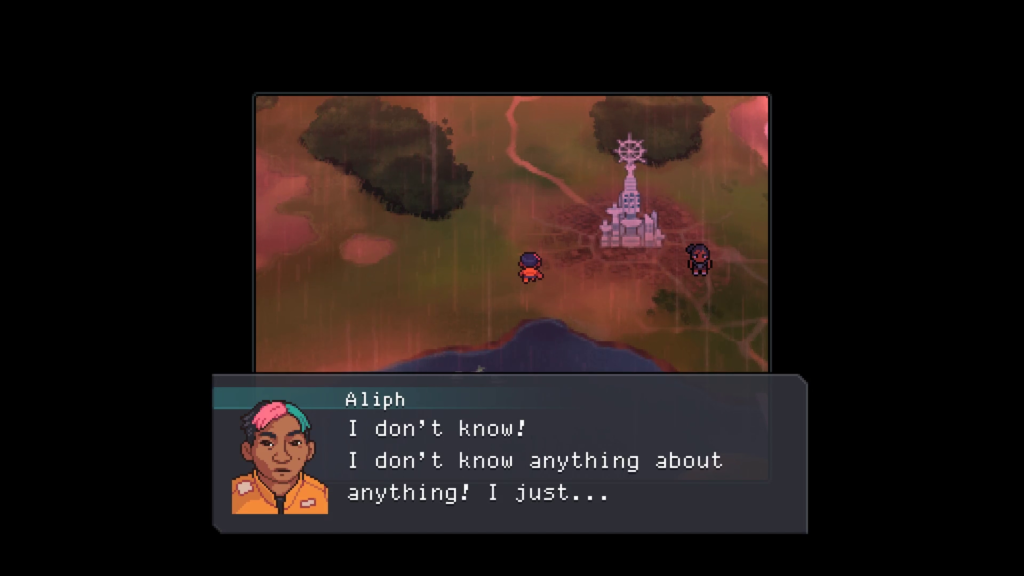
The central metaphor about light and dark energy concerns two main subjects: hierarchical power structures and climate change. The society of Whiteforge, the world’s dominant city-state by far, is meant to parallel “modern civilization” with its militarism, class stratification, and climactic destruction. The entire story is framed as a warning to the real-world civilization here on Earth. Whiteforge proves unsustainable because it is fundamentally unjust and because its effect on the environment guarantees a natural feedback loop akin to climate change—here taking the form of kaiju-like monsters called Geomes and a global deluge.
Light energy is vertical. Its supremacy corresponds to hierarchy in the obvious class divides of Whiteforge. Dark energy is horizontal, associated with the soil and the presumably egalitarian tribes whose descendants build Whiteforge. Aliph’s relationships with these two types of energy and the social values they imply correspond, like the player’s relationship to the Order and Chaos faction leaders in a Megaten game, to Mayor Biggs (light energy) and Yara (dark energy).

Biggs’s relationship to light energy is obvious. A literally lofty ruler, this politician with the coiffured hair of a cartoon big shot inhabits the heights of the Whiteforge Apex District and presides over the power plants and battle against the end of the world. Biggs is “out-of-touch with the constituents” and seems to lead a sexless life, with no reference to any kind of partner. Yara, in comparison, is a poor queer woman close to the earth who labors in the soil and does not fear death, which she is close to from the beginning, first appearing to eulogize her partner. The preview aligns characters with certain energies, and Yara stands (or rather kneels) on the dark energy side.

Biggs, aloof even when he tries to be kind, uses Aliph for his propaganda and commands her to carry out missions. His dialogue portrait always marks him as “Mayor Biggs,” including his title to emphasize that he is the player’s superior. In his last scene, Biggs tells Aliph she is like a daughter to him—an inferior rather than a friend. Biggs is always hierarchical in his relationship to the player avatar.
Yara, though grieving her girlfriend, is emotionally intimate with Aliph, cooks her meals, provides advice, hugs her as they both die, and, depending on how one reads the end of Act 3, might become her sexual partner (though in the ending, Aliph still calls Yara only her “friend”). Yara is very much Aliph’s reciprocal equal, rejecting her only when Aliph begins living in the upper district.
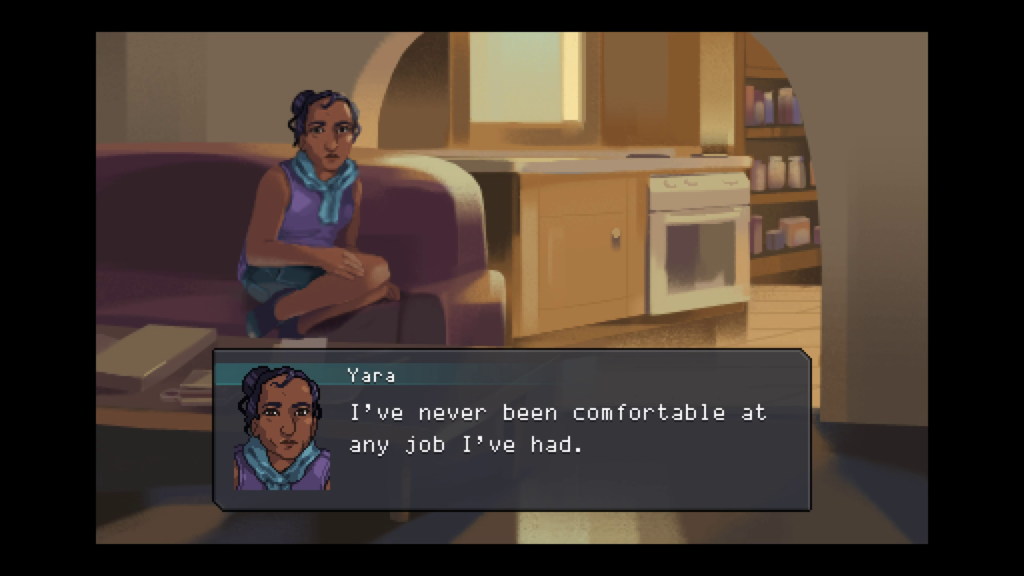
Much of Even the Ocean’s political commentary is subtextual. Even the Ocean is set in a high fantasy world, one relatively mundane compared to The Lord of the Rings or The Legend of Zelda but nonetheless not our own, with a distinct history and society. A strong class consciousness permeates Even the Ocean, made visible, in sci-fi tradition, through a difference in literal elevation in Whiteforge. The wealthy live in the white-and-blue levitating towers, balconies, and art museums of the Apex District and the poor in the sprawling one- to three-storey brown and gray buildings of the districts along the Ground Line, with settings like the garbage dump but also with more egalitarian structures like the library. As Aliph says, the Apex District looks like the future but “is actually just a fraction of Whiteforge as a whole. Ground level Whiteforge still houses the majority of the population, including me!” The player, of course, is made to identify with Aliph, with the working class. However, this class metaphor does not quite succeed.

While there is no other implication that colonialism ever existed in the world of Even the Ocean as it has in the real world, the class line is also racialized. The wealthy people of Whiteforge’s Apex District, characters such as Wodsnick, Ronald, and Dave, are predominantly white, whereas almost every other person in the world, including Aliph, appears to be what folks call a POC. Aliph is not Asian because there is no “Asia” in this fictional world, but she is Asian-coded. In this subtextual narrative, Aliph becomes a kind of “model minority” class traitor.
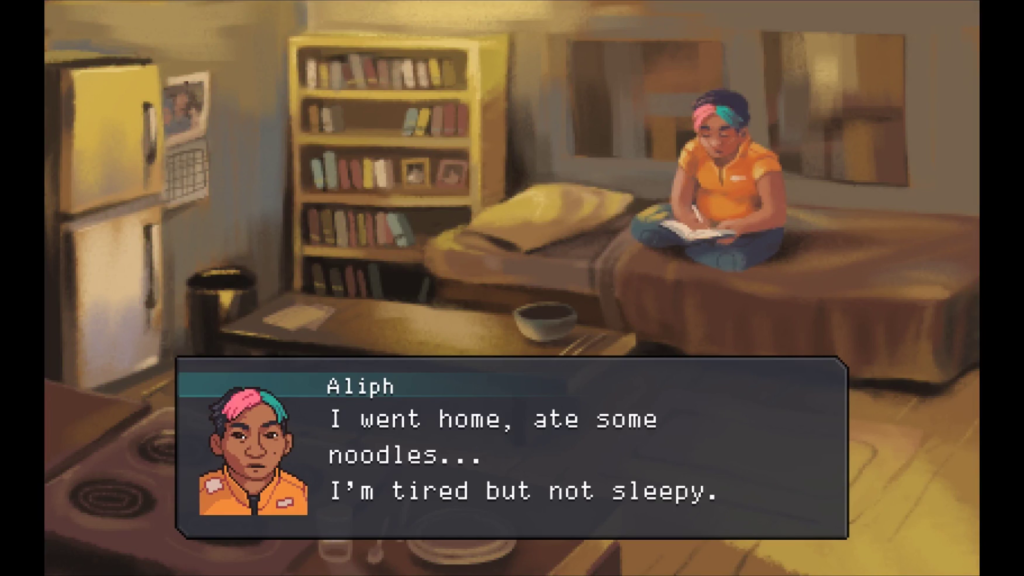
After she completes the repair of the Fay Rouge Power Plant, Aliph finds herself summoned to meet Biggs, who lionizes her as a publicity stunt. Other characters and Aliph herself note that Biggs singling her out is so unusual, but Aliph artlessly ignores, mostly, that Biggs is using her. Later, Biggs rewards Aliph with an apartment in the Apex District at the same time that he and Wodsnick let her in on the true scale of the threat to the world and the importance of her work. This corresponds to Aliph joining the upper class and implicitly accepting their values, even as her spacious apartment fails to bring her the comfort of her modest home in Murex Park. The move disconnects her from the community of Aloe, Yuca, and most especially Yara, who becomes hostile toward her in a pivotal scene in Act 3.
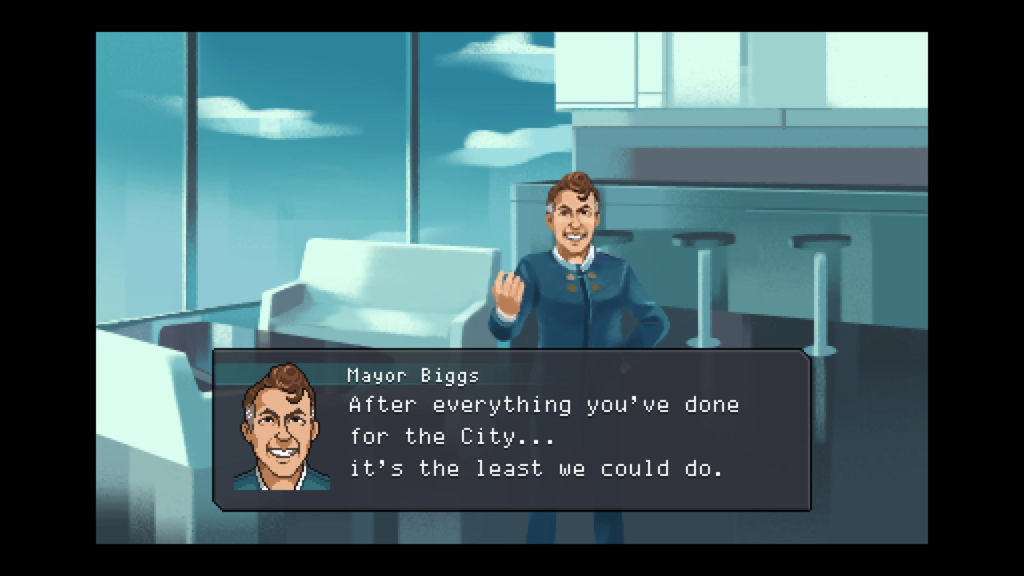
In the subtext of the story, it is true that the Aliph becomes a kind of “model minority” class traitor, as I state above. However, in the text, Yara comes off as irrationally mean in this scene. In particular, it seems bizarre that what really sets her off is Aliph wanting to save the world.
“I have to do this…” says Aliph. “I have to fight the Geomes. For Paxton. For… for Cassidy.” (At this point, both Paxton and Cassidy have lost their lives to the Geomes. Their deaths really do feel more somber than they would in a more fantastical video game.
“Cassidy never knew about all of this,” says Yara.
“I-I know… I just meant… Cassidy would have… would have fought to save–”
“Don’t tell me what Cassidy would have done! Of course Cassidy would have saved the world if she could have!”
“I don’t get why you’re mad at me!”
“I don’t know, you’re just really ticking me off.”
“[… I]f you’re just gonna be mad at me, then I’m gonna go.”
“Good.”
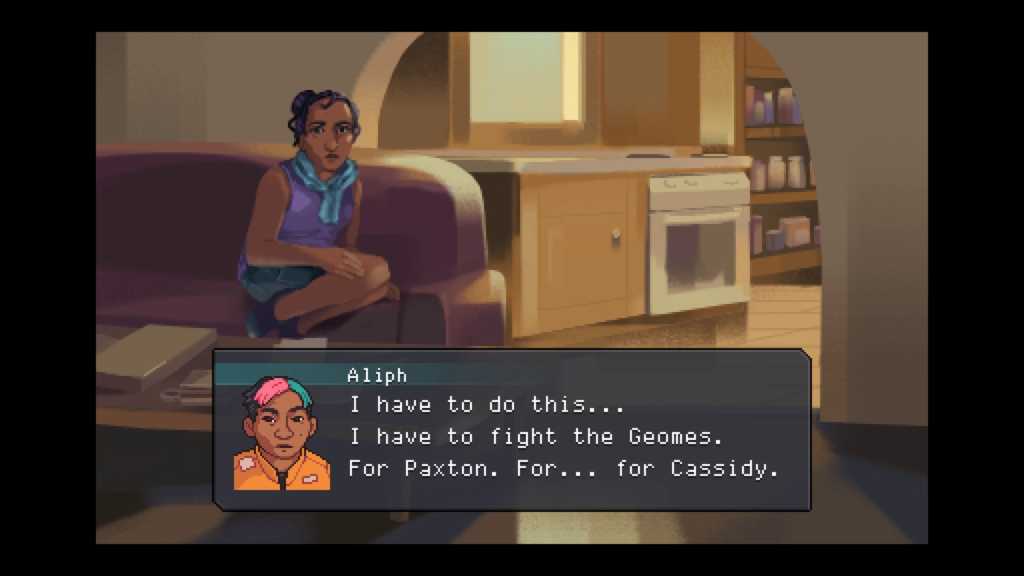
It is true that Biggs and Wodsnick are wrong about how to save the world. Yara intuits this, but at this point in the literal story, as opposed to the subtextual one, there is no reason to doubt that the Geomes are going to destroy the world. There is no evidence the leadership is wrong except that Wodsnick is arrogant and lacks the emotional intelligence to respect Aliph’s trauma. While Aliph may be insensitive to bring up Cassidy, it seems odd that Yara is more angry at Aliph than the a giant monster that killed her partner. For Yara to be upset, Aliph might instead adopt the snobbishness and aloofness of the ruling class. She might comment on how small Yara’s house seems to her or how underwhelming her kitchen appliances—just something to make her actually warrant rejection besides passionately not wanting the human species to go extinct. Or perhaps Yara can have some solid reason to believe that fighting the Geomes is wrong or that Aliph repairing the power plants is immoral or has some negative effect. But instead, in Even the Ocean, having compassion for people is a vice because people are basically bad.
Despite the centrality of class politics to the story, outside of the final scene, characters never explicitly mention wealth disparities. Where the metaphor of the unsustainability of class society connects with climate change is the revelation partway through Act 3 that the stakes of the story far exceed the interpersonal drama of a power plant technician. This occurs with the introduction of the Geomes as what is attacking the light energy power plants that fuel Whiteforge and “our way of life.” From the records of a lost civilization, Karavold, whose skyscrapers and cars resemble those of modern-day Earth, Biggs and Wodsnick know there have been a series of other similar civilizations before Whiteforge. Each ended with the Geomes appearing and then an apocalyptic global flood or drought in an ongoing cycle of destruction and regrowth. Biggs and, in turn, the obedient Aliph believe that killing all three Geomes will stop the coming flood.
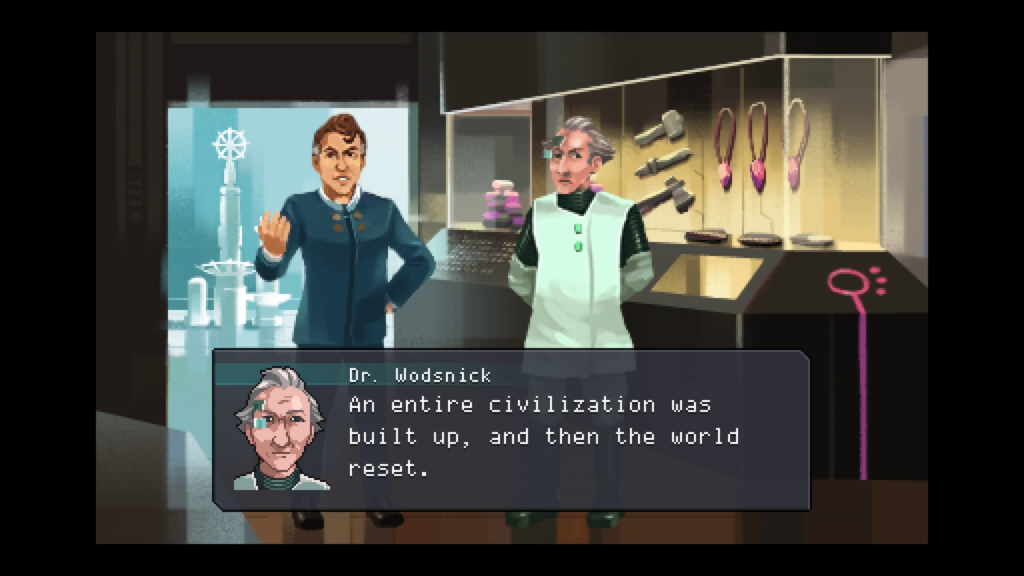
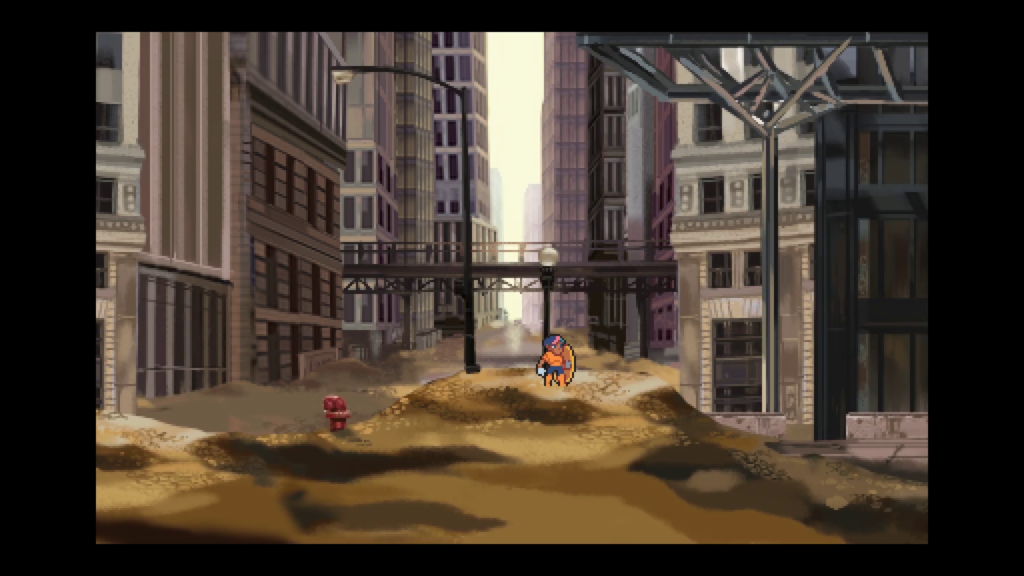
Nobody offers any alternative route until the finale, when the entire cast bafflingly (but, as it turns out, correctly) begins treating an obnoxious drifter named Humus as an immortal, inhuman being of great wisdom. Humus is an avatar for the earth, not angry or wrathful—but indifferent. Yara, who accepts Humus like Jane accepts nature as it is (more on Jane later), rather than Aliph, who, like Wodsnick fleeing from greater knowledge to shore up his property, rejects Humus as impossible to understand, manages to get the mysterious drifter to reveal that the Geomes had been out to weaken the flood by destroying the power plants. The severity of the flood or drought corresponds to the degree to which the civilization disturbs the balance of light and dark energy.
This leads to a finale in which Aliph firmly sides with Yara to reject Biggs, who, despairing, attempts to keep the Apex District of Whiteforge levitating to wait Noah-like for the flood to recede. This shocking abandonment of the poor, or not-so-shocking in light of the survivalist schemes of certain real-world rich thieves, marks Biggs’s first and only genuine betrayal.
The challenging final level has the player climbing the Sunrise Spire that is the symbol of Whiteforge, of the “progress” that Biggs and Wodsnick represent, to reroute the power to rebalance the light and dark energy, embracing dark energy to sink the Apex District and avert the flood. The civilization of Whiteforge, then, is unsustainable because it upsets the balance of nature. Summarily shutting down the power plants would presumably kill thousands of people dependent on the electricity. But in the metaphor of white energy corresponding to a rigid hierarchical society, this means Aliph—a working class heroine—must rise up against the ruling class to, siding with Yara and dark energy, create a more horizontal, a more balanced, society.
Except that Aliph’s gambit fails! All Aliph does is guarantee that literally everyone will drown. Biggs might have acted out of cowardice and with appalling inhumanity toward the poor, but somehow, telling the upper class, including sympathetic characters like the museum tour guide Violet, that they must all die alongside the rest of us seems like the wrong solution. Even the Ocean denies the player even the option to, say, travel north to try and save Aliph’s mother instead. It also seems like the wrong ending to a story that up to this point seems largely un-judgmental.
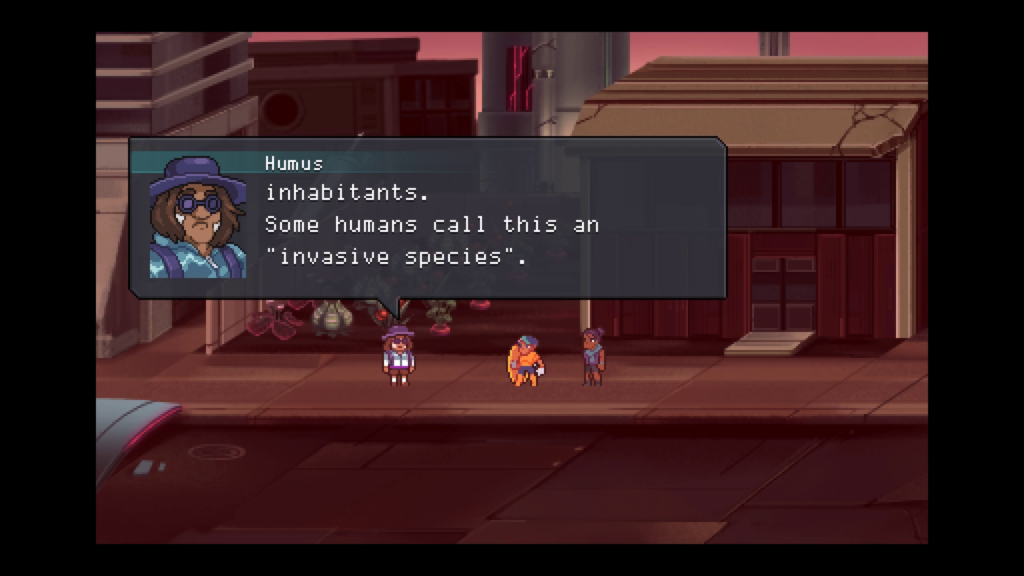
In this ending, the characters describe humanity as an “invasive species” destroying Earth. Humus inspires Yara to monologue about what has gone wrong and, in turn, the core message of the story:
“Maybe the problem isn’t that powerful people are transformed by their power… maybe the problem is that they *aren’t* transformed. Humans are like any other creature: we do what we need to do to survive. But in our society, with our technology… some people exist in a space where immediate, physical concerns about things like food and shelter vanish completely. And yet they keep on exerting power and exerting power. They build giant floating towers like it’s the only thing keeping them alive… even though that continues to be further and further from the truth! And yet that unnecessary exertion of power is destructive. Individual acts of violence are a necessary part of the struggle for survival and growth in any ecosystem… but as systems of power become more and more unbalanced, the violence of the powerful becomes less justifiable.”
This notion of the violence of the ruling class as an irrational continuation of the “survival of the fittest” in a society no longer requiring this competition explicitly links light energy dependence to class society. However, this could also be read as implying that humanity should be in a state of constant “war of all against all”-style violence, a nasty reading that Analgesic Productions would never intend but that seems reasonable. I also object to the suggestion that the world needs a little violent hierarchy to keep up the balance, as with Terranigma’s incoherent treatment of light and dark as forces to be kept in balance, despite the dark in that story being unambiguously evil. Furthermore, this concedes the point to the pseudoscientific social Darwinists: human society exists in an ecosystem, or in many ecosystems, but it is not itself an ecosystem.
Aliph feels terrible guilt for having doomed the human species to near-extinction and having murdered the entire cast including her own mother and dozens of children, but Yara shrugs it off: “I know when you do something wrong… sometimes it feels like you have to pay by feeling bad enough somehow. Like that’s justice. But… it’s just not.” This is fine advice for daily life. In context, however, it comes off as unutterably callous, as though Aliph is wrong even for feeling bad that everyone will die because of her. Yet the story, here as elsewhere, depicts Yara as a voice of moral authority. The story suggests humanity deserves it. Aliph describes the deluge in biblical terms as punishment for sin: “Whiteforge, the light energy, the imbalance… our civilization was corrupted by power. Is that it, Humus? We became greedy and exploitative, and this… this is our punishment.” There is again the parallel between power imbalance of the few and the many and the reliance on light energy.
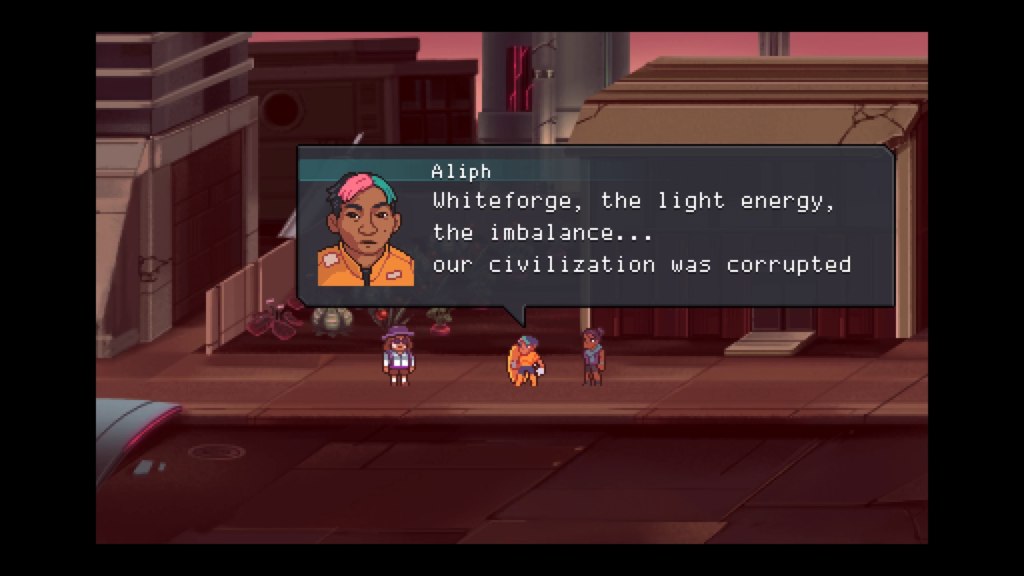
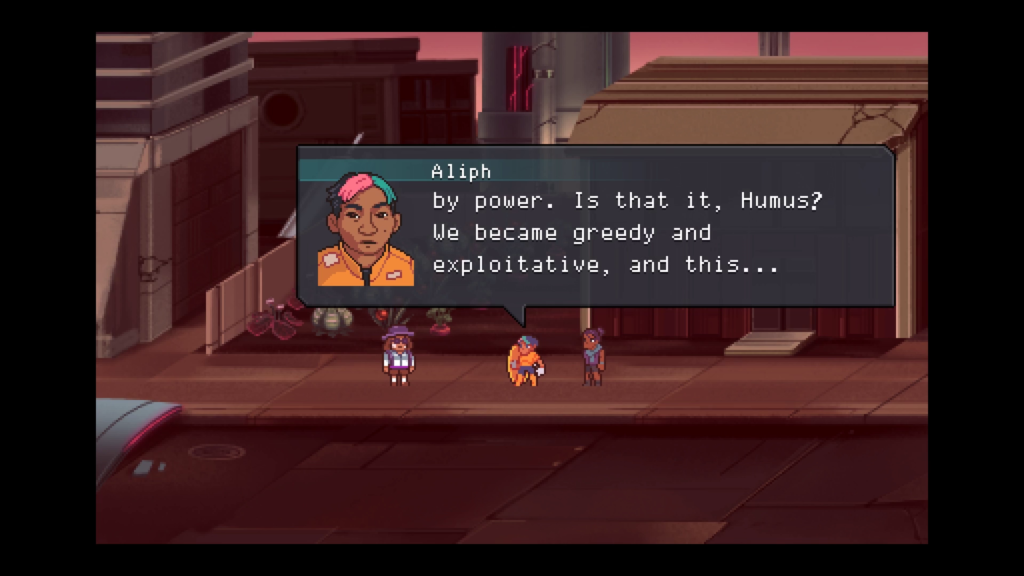
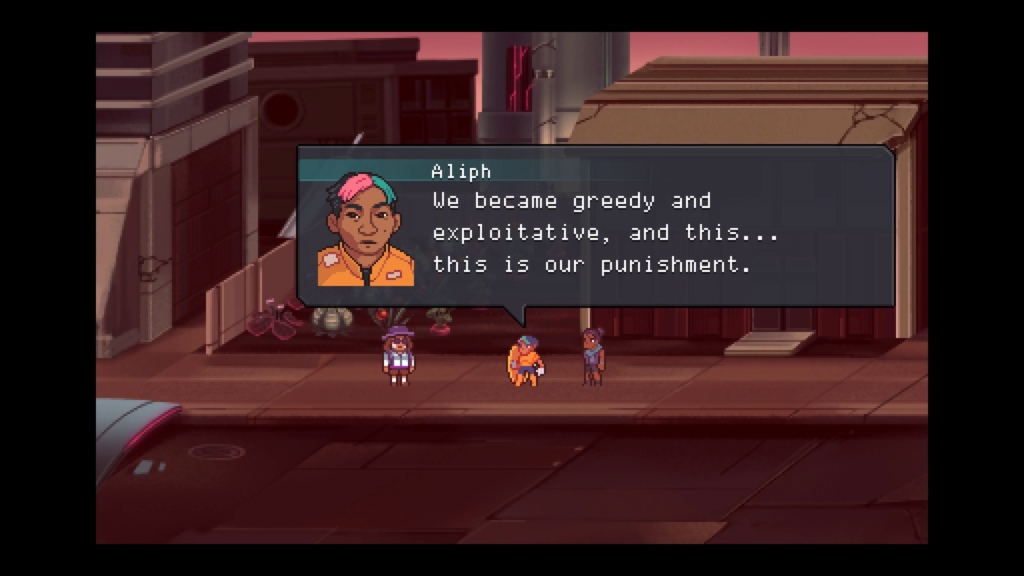
The issue is, again, that Whiteforge’s injustice is subtext. Yes, the player can tell class stratification exists by the clear and racialized differences between the Apex and Ground districts. But Even the Ocean is too mellow to depict this greed and violence that damns humanity and renders the “way of life” of Whiteforge genuinely unjust. There are no cops. There are no soldiers. No war is occurring anywhere in the world. The prison, aside from Humus, seems empty. At no point do conquest, greed, or the corruption that concerns Aliph seem to exist. Poverty is romanticized, Yuca and her friends building wondrous and useful obstacle courses in the junkyard, Yara and Cassidy growing their own garden pure enough to summon the immortal Humus, and Aloe running a charming 7-Eleven-style store that sells her delicious home cooking. Aliph’s house in Murex Park is more inviting, warm, and comfortable than her sterile apartment in the Apex District. None of the downsides of poverty—deprivation of healthcare, lack of clean water, having to work multiple miserable jobs, and so forth—exist in Even the Ocean.
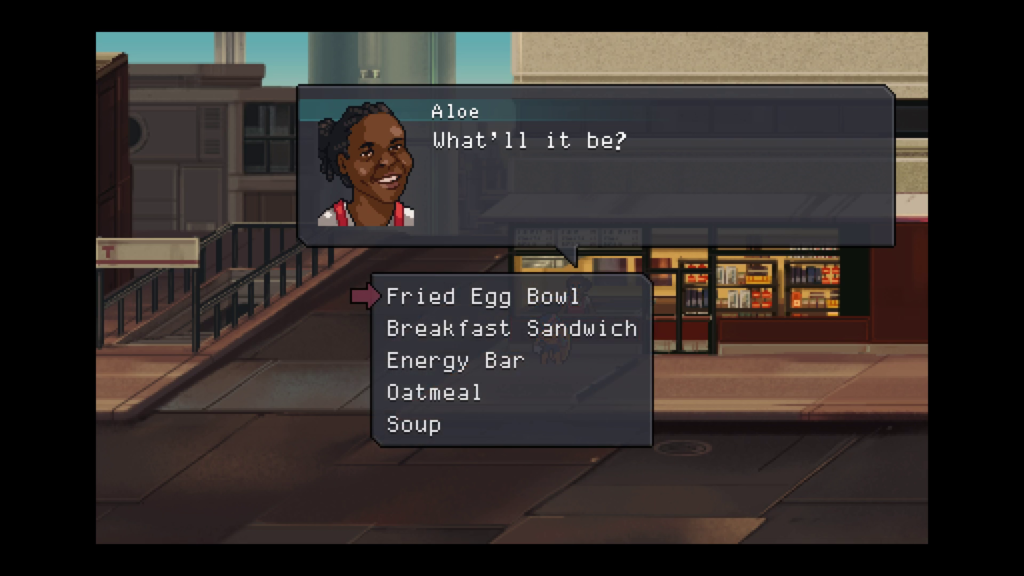
Biggs, in a twist on the classic twist, is not a deceitful villain but an honest if unpleasant man trying his best to save the world the only way he knows how. Most of the upper class (Dave, Athiya, Gavin, Biggs, etc.) are shallow, but even when they form an angry mob to pursue Humus, these social and economic elites, despite Dave being nasty to Yara, do not want to harm them, use no weapons, call no police, and accept an apparently nonviolent solution. The most negative depiction of the wealthy by far is a throwaway character named Barton who, from annoyance, wants Aliph to murder the sentient Starfish at Restview Beach. While Barton’s cruelty is unconscionable, and it would say something about Aliph were the player to acquiesce to his scheme, a lone scumbag on holiday does not make for a damning portrait of the abuse of power.
The imperialism of Whiteforge appears primarily in relatively minor forms. I call this imperialism “relatively minor” not because it wouldn’t matter but in contrast to, for example, violent conquest or brutal labor exploitation of the periphery. While financial power can also be insidious, what of it exists in the world of Even the Ocean is still soft. Whiteforge shrinks and dominates neighbors’ economies as labor moves to the big city. Damien insists to Aliph that Riverton “used to be a large, agriculture-driven town” and regrets that Whiteforge has centralized food production in its environs (according to him, as there are no fields of crops visible around Whiteforge). Yet Riverton remains a vibrant, happy, beautiful community full of handicraft and literature and surrounded by bountiful cereal fields. Where are the negative effects that the story wants the player to understand are occurring? Why are there no abandoned farmhouses, no businesses forced to shutter? In Oscar Basin, the vapid townsfolk and their mayor, the tragic Biggs wannabe Chairman Vale, reshape the local culture to be like that of the big city to appeal to investors. But this sequence is used as comic relief, softening the conflict. The cruelty of similar real-life projects is absent: not a single cop or soldier appears in Oscar Basin, either. Is this really enough of an atrocity that everyone in town, including Dolly, Vale’s daughter who embraces direct action to combat this assimilation, is completely corrupt, warrants Humus, Yara, and Aliph’s condemnation? What is the culture Whiteforge’s financial power has erased? The player never learns, so it never seems too horrible.
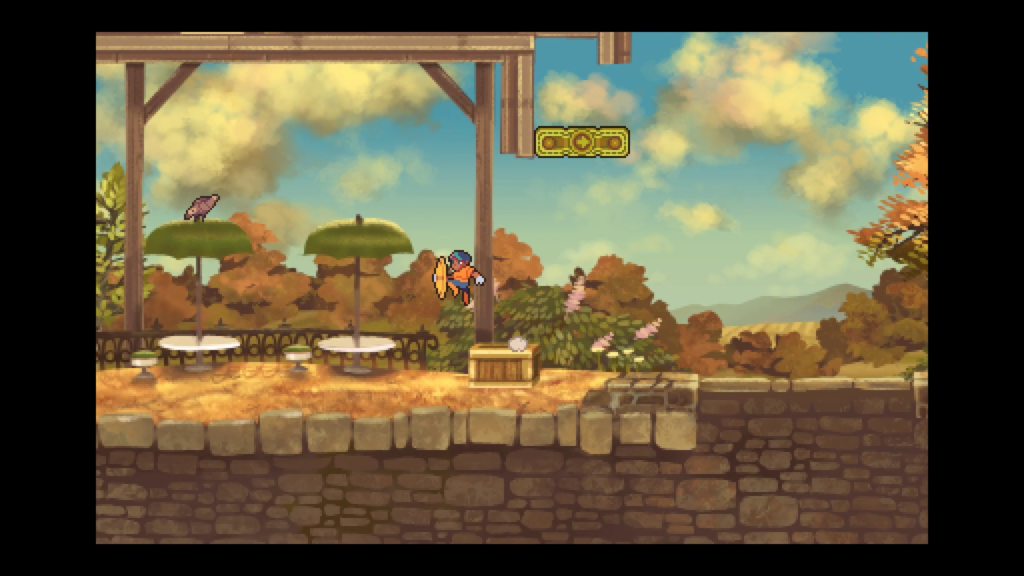
Jane, part of Wodsnick’s expedition that discovered Karavold prior to the events of Even the Ocean, all but states a more positive moral than the ending offers: “Karavold’s destruction must’ve spooked the leadership team. But instead of trying to learn more, they just retreated to what they know best… towers and guns. You know, Aliph, I used to think they really cared about understanding the natural world. […] We’re all part of it, we’re all interconnected with everything! But the more I tried to get people to understand my work and its relevance… the more I realized people don’t really see it that way. To a lot of people… everything that’s not the City is ‘Nature’. Some monolithic and exotic ideal[.] […] If they’d let me have my say, I’d have… well… I guess they didn’t[.]” Aliph responds: “Maybe you could have helped. Maybe we wouldn’t be in this situation now…”
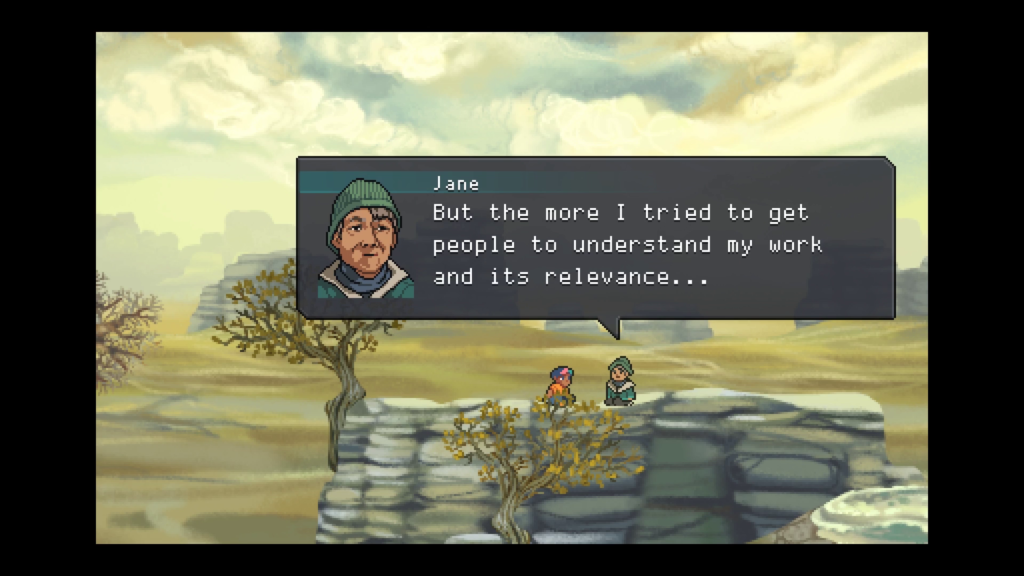
Even the Ocean implicitly critiques militarism, then, critiques using only weapons and force to solve issues in Biggs and Wodsnick turning to violence to fight the Geomes. This, as Jane makes explicit, is their fatal flaw. Upon learning about the Geomes and the flood, Wodsnick and his team halt their research into nature and archeology to focus on consolidating Whiteforge’s defense capabilities. Had they put science toward expanding knowledge instead of expanding military power, they might have learned the folly of their imbalanced civilization. But, again, this violence is not imperial or class-based but strictly directed at giant inhuman monsters which, until later on, seem to be attacking innocent people. If the “towers and guns” Jane speaks of correspond to oppression like real militarism, the player should witness some actual oppression.
My reading may also re-contextualize my earlier criticism of the overworld. Aliph has a world to explore, to learn all about like Jane or the oddball Travel Bob choose to. The player is primed to look around, so Aliph may want too as well. But narrow obedience to Whiteforge comes first. No More Heroes is notorious for its realistically sprawling overworld full of almost nothing. While many consider this a shortcoming, the size acts as a humorous and bleak reflection of the wretched player character’s complete failure to engage with anything in his community beyond nerd culture and mass murder. Far from a mistake, this is a meaningful design decision. The overworld of Even the Ocean may serve a comparable purpose.
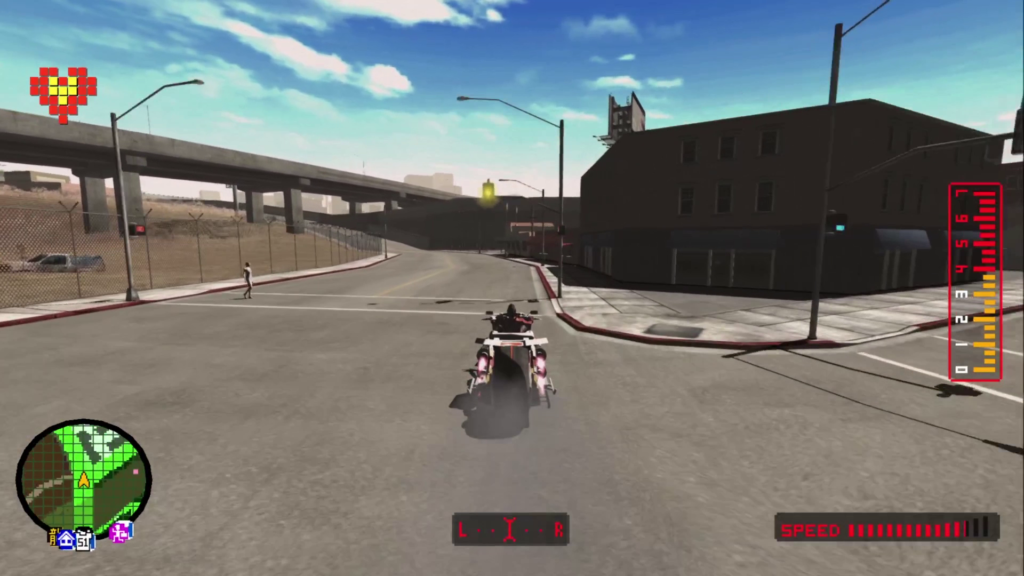
The world of Even the Ocean seems more kind, just, civil, and even balanced than the real one. If the concentration of power by the Whiteforge elite is really so corrupt and vicious, Analgesic Productions should show the player some of that corruption and viciousness. A video game set in a society that might warrant such harsh judgment would be fundamentally different and much nastier—there would probably be some combat, for one—but the general compassion of Even the Ocean renders the ending incoherently harsh. I would take this cruelty as the crux of the tragedy, a display of how the most innocent pay for the guilt of the powerful, were it not that the powerful seem mostly benign and that, moreover, the authorial voice shares Yara and Aliph’s misanthropic perspectives. For such a haunting ending, the lesson that we need more balance in life seems oddly facile.

The central paradox of Even the Ocean is that it at once overflows with affection for a vast and diverse cast of people of all ages, colors, genders, and sexualities, all of whom are honest and operate in good faith, but it concludes by condemning absolutely every one of them—Yuca and her hardworking friends, Garrett the dedicated but unnecessary bridge guard in Riverton, the couple Wesley and Myron who run the library in Magdal Woods—to death for having existed in an allegedly decadent society with unsustainable electricity generation and seems to justify it.
There is, however, an attempt to dodge nihilism by implying that a civilization that achieves a “balance” between these types of social organization might not destroy itself and the environment. To Humus and so to nature itself, individual actions are irrelevant. But waiting for the flood, Humus adds: “I too have a limited perspective in the face of the sheer complexity of existence.” Kittaka and Han-Tani wisely want to avoid determinism. Yara follows up: “I don’t think we can ever really know what we have true control over, or what humans are capable of as a whole. And if we don’t know… well, then there’s some worth to fighting for things, even if they seem impossible. Or trying to think of different paths in the face of what feels inevitable.”
But these feel like underwhelming cop-outs. They also seem to miss the real point. Even the Ocean depicts nature as consisting of a series of cycles: the drought, the flood, the drought, the flood—life and death (Anodyne 2 wisely adds birth). Despite the talk of corruption, the actual sin of Whiteforge’s “way of life” as actually depicted is a failure to recognize what Jane points out: that “civilization” is not distinct from but exists within nature. People, then, must change culture as nature changes instead of irrationally sticking to their irrational structures. Whether a milder flood would be survivable is unclear, so this point too is ambiguous.
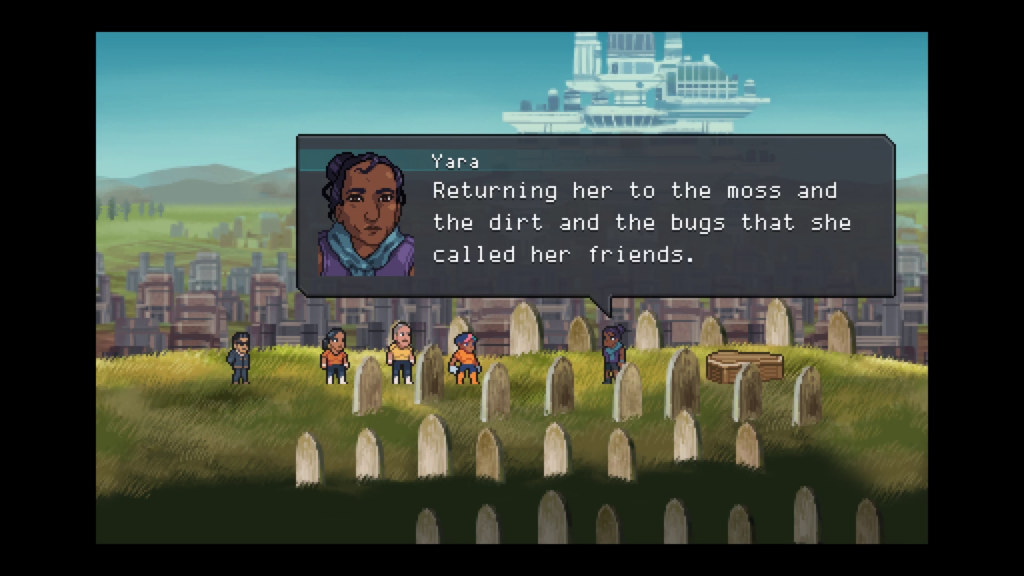
The clearest representation of this point comes from, ironically, Chairman Vale before Whiteforge corrupts him. Describing (to his comically oblivious daughter) why the water in fountain in the tundra flows instead of freezing solid, he says, “The water doesn’t freeze because it’s always in motion, always cycling. If it sat still, it would freeze solid. It’s just like us people. We need to keep moving, keep learning and trying new things, so we don’t get stuck. Frozen.” Vale admits that the fountain is also heated, indicating that a responsible use of technology is possible—as I hope people making video games would believe! But after Vale ossifies into Whiteforge’s mold and his community rejects all negative emotions, he stops going on walks and forgets the fountain, which malfunctions and freezes. Dolly’s friend, Tracy, points out to her that the expanded water will rupture the pipes. Not only frozen, the fountain is irreparable.
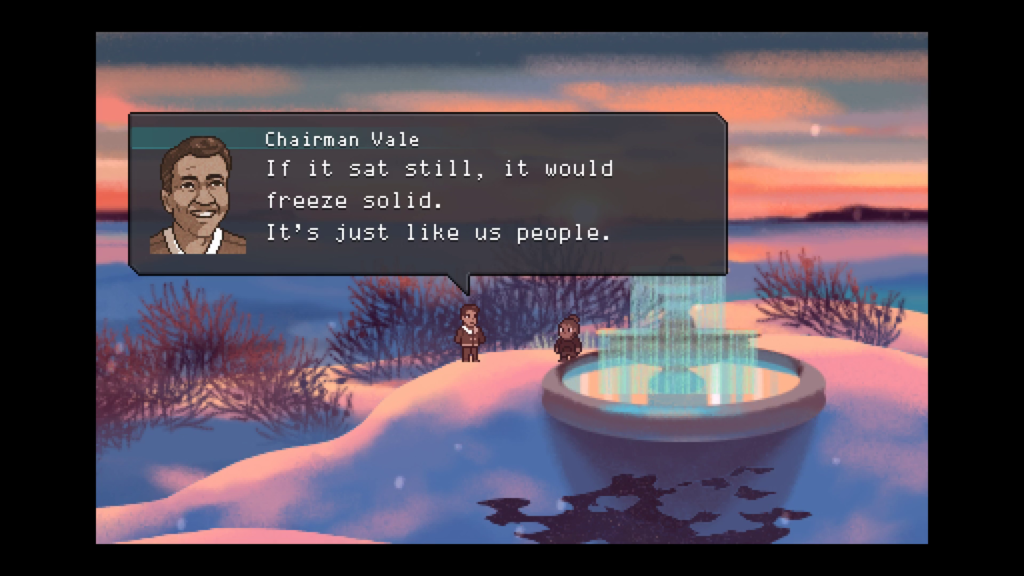
The fountain corresponds to the Whiteforge civilization. To spur adaptation and change is the real goal of the Geomes’ intervention, and Whiteforge attempting to freeze the fluidity of life is the real reason for its destruction. At least, that better aligns with the actual in-game events. Instead of embracing oblivion, humanity must realize their civilization is part of the earth and adapt and change it with the cycles of nature, in this way also revitalizing their cultures. And instead of fearing change, up to and including death, they must accept that cycles of growth are part of existence in an ever-fluid universe. So Even the Ocean may offer more positive takeaways than what seems to be the primary message, and that is discounting the positivity of the cast’s sheer diversity.
That Aliph comes far too late to effect positive change might suggest the authorial perspective on the current state of the real world—it is too late. Or perhaps Yara is correct and Aliph’s actions could not have mattered much anyway, but that is a flaw inherent to any story that attributes world-changing events to a lone hero. Anodyne 2 follows and even intensifies Even the Ocean’s concerning association of positive moral character with wanting to die, though at least in Anodyne 2 Kittaka and Han-Tani depict the player’s hierarchical, death-fearing boss as legitimately cruel and ill-intentioned instead of, like Biggs and compatriots, somewhat arrogant but well-meaning.
As much as I wish I could say I enjoyed Even the Ocean, the experience feels pleasanter as a memory than when I held the controller. I remember Even the Ocean as a mellow platformer and as a frustrating, disturbing political story about the apocalypse. But while playing it, I was usually bored with prolonged, forgettable interactions between bit characters and a dull main character and was disappointed by an unrelenting linearity. But an intriguing and heartfelt video game is always preferable to a boring one or to highly polished hollowness.
Did you know you can follow me on Twitter? You can. 😊
